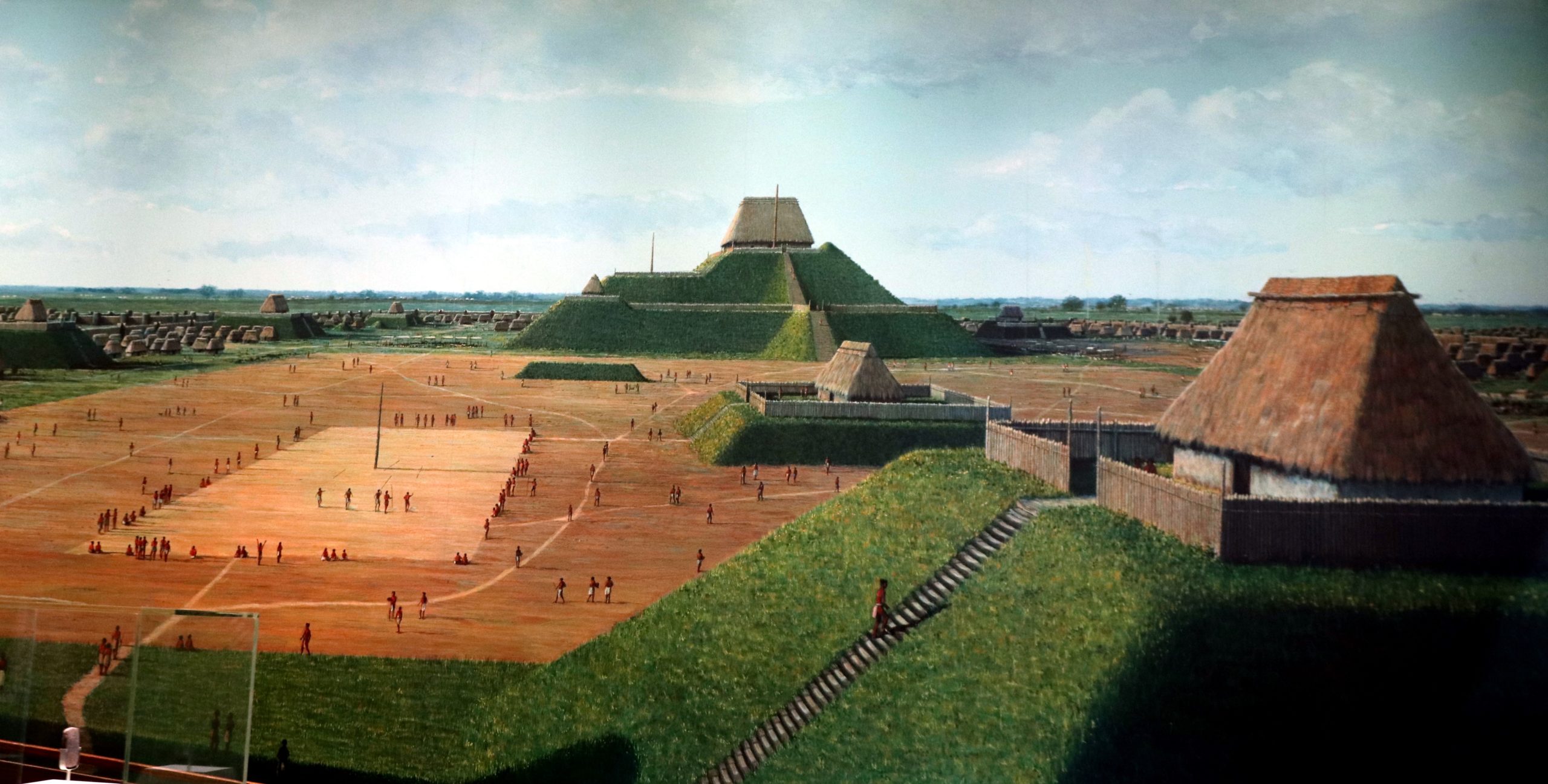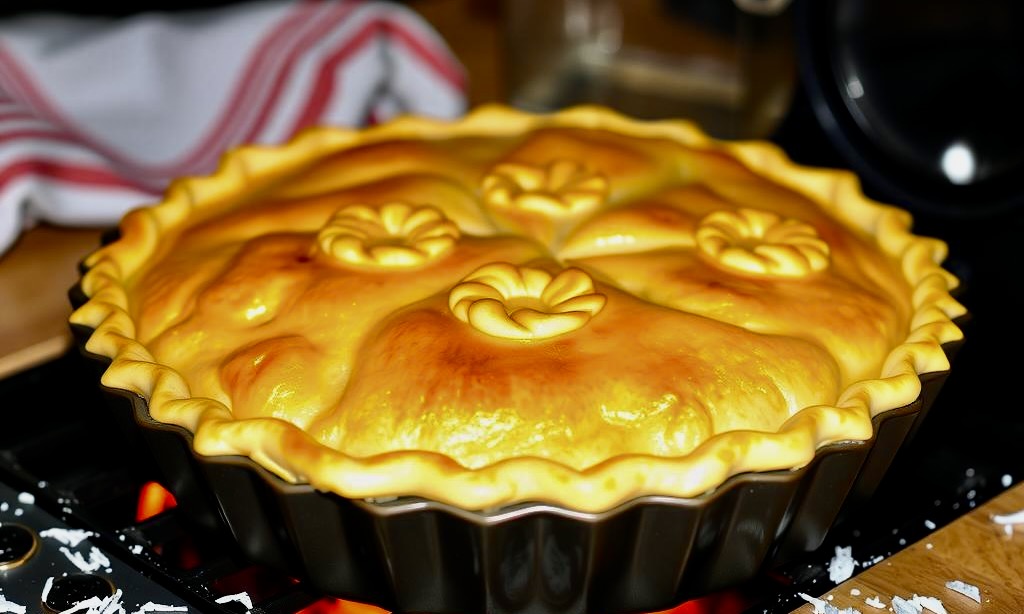
Cahokia Mounds as they appeared in ancient times. This is now a An UNESCO World Heritage that can be visited at 30 Ramey Street Collinsville, IL. The location is only 6 miles (10 km) to St. Louis, MO, just across the Mississippi River, so it belongs to the state of Illinois.To learn more about this fantastic civilization along Mississippi flood plain visit : www.cahokiamounds.org
Native American and Indigenous Winter Solstice Traditions and Perspectives
The winter solstice is the shortest day and longest night of the year in the Northern Hemisphere. It marks an important turning point when the sun begins its journey back, bringing longer days and the promise of spring.
Quick Facts:
- When: Usually December 21st or 22nd each year
- What Happens: The Northern Hemisphere has the fewest hours of sunlight
- Cultural Significance: Many Native American communities hold religious ceremonies or community events
- Universal Theme: Honoring the sun and its life-giving power
- Ancient Understanding: Indigenous peoples observed the solar system carefully and incorporated this knowledge into their architecture, ceremonies, and daily life
Teaching Note: For thousands of years, Indigenous peoples have tracked the sun’s movements with remarkable precision. Their observations were not just scientific—they were deeply spiritual and essential to their survival and way of life.
Indigenous peoples built remarkable structures aligned with the winter solstice, demonstrating their sophisticated understanding of astronomy.
Cahokia: Ancient City of the Sun
Location: Near present-day St. Louis, Illinois, across the Mississippi River
Time Period: Over 1,000 years ago
What They Built: Temple pyramids (mounds) and a circular structure called “Woodhenge” made of wooden posts
The Discovery: When scientists observed the sunrise from Woodhenge on winter solstice, they found the sun aligned perfectly with both Woodhenge and the top of a distant temple mound. On summer solstice, it aligned with a different temple mound.
What This Tells Us:
- The people of Cahokia venerated the sun as a deity
- They incorporated astronomical knowledge into their architecture
- Scientists believe they held rituals to honor the sun as a giver of life and to mark the new agricultural year
- This demonstrates complex mathematical and engineering skills
- Similar structures exist in Indigenous sites across the Americas
For Students: Imagine being able to build a structure so precise that, 1,000 years later, the sun still rises exactly where the builders intended on the winter solstice. This shows the incredible skill and knowledge of ancient Indigenous peoples.
The Zuni Pueblo in western New Mexico continue their agricultural and spiritual traditions today, including winter solstice ceremonies.
The Shalako Festival
Who: Zuni Pueblo people in western New Mexico
What They Grow: Corn, beans, squash, sunflowers, and more
When: At the time of winter solstice (dates selected by religious leaders)
The Ceremony: A multiday celebration where six Zuni men dress as giant bird deities
Purpose: These men carry Zuni prayers for rain “to all the corners of the earth”
Meaning: The Zuni deities are believed to provide “blessings” and “balance” for the coming seasons and agricultural year
Important Understanding:
Religion scholar Tisa Wenger writes: “The Zuni believe their ceremonies are necessary not just for the well-being of the tribe but for the entire world.”
Teaching Point: This demonstrates how Indigenous spiritual practices often emphasize interconnectedness—the belief that ceremonies benefit not just one community, but all of humanity and the natural world.
Cultural Respect:
- The Zuni are intensely private, and most events are not for public viewing
- This privacy should be respected and honored
- What they choose to share publicly is a gift and privilege
Not all Indigenous peoples ritualized the winter solstice with religious ceremonies. The Blackfeet tribe in Montana celebrated in different but equally meaningful ways.
Blackfeet Winter Solstice Traditions
Location: Montana
Calendar: The Blackfeet kept a calendar of astronomical events, including the winter solstice
Name for the Sun: “Naatosi”—they marked the “return” of the sun on its annual journey
Tipi Orientation: They faced their tipis (portable conical tents) east toward the rising sun
Celebration Style: Games and community dances rather than large religious gatherings
Community Gatherings:
- Each community held their own gatherings during winter solstice
- Unique drumming, singing, and dance styles for each community
- A time for families and communities to come together
- Focused on joy, connection, and celebration
Historical Context – Important to Understand:
During the early reservation years, the U.S. government restricted Native American religious and cultural practices. The Blackfeet adapted by moving their dances from traditional times on their religious calendar to dates acceptable to the government, such as Christmas Day or New Year’s Eve.
What This Teaches Us: Indigenous peoples found ways to preserve their culture and traditions even under oppression. This resilience is part of their strength and survival.
Personal Story from the Author:
“As a child, my grandmother enjoyed attending community dances at the time of the winter solstice. She remembered that each community held their own gatherings, with unique drumming, singing and dance styles. Today, my family still spends the darkest days of winter playing card games and attending the local community dances, much like my grandmother did.”
— Rosalyn R. LaPier
Common Threads in Winter Solstice Observances:
✦ Honoring the sun and its life-giving power
✦ Marking the return of light and longer days
✦ Community gathering and connection
✦ Spiritual significance and renewal
✦ Hope for the agricultural year ahead
✦ Interconnectedness of all living things
What Students Can Learn:
- Ancient Knowledge: Indigenous peoples had sophisticated understanding of astronomy
- Interconnectedness: Many Indigenous worldviews emphasize that what affects one affects all
- Resilience: Indigenous cultures have survived and maintained traditions despite centuries of oppression
- Diversity: Even among Native American nations, there are many different ways of observing the same celestial event
- Living Traditions: These are not just historical practices—many Indigenous communities continue these traditions today
✅ DO:
- Emphasize Indigenous peoples’ sophisticated astronomical knowledge
- Acknowledge that these are living traditions, not just history
- Recognize the diversity among Native American nations
- Use the term “Native American” or “Indigenous peoples” (capitalize both)
- Invite Native American educators or community members to share (with respect for their privacy)
- Connect to scientific concepts: astronomy, seasons, solar system
- Discuss resilience and cultural survival
❌ DON’T:
- Treat Indigenous knowledge as “primitive” or “simple”
- Appropriate sacred ceremonies or rituals
- Present all Native Americans as the same or having identical traditions
- Use the past tense exclusively (e.g., “Native Americans believed…”) when traditions continue today
- Share details of closed ceremonies or private religious practices
- Turn sacred traditions into crafts without proper context
Critical Historical Context:
It’s important for students to understand that Native American religious and cultural practices were actively suppressed by the U.S. government for many decades. Despite this oppression, Indigenous peoples found ways to preserve and continue their traditions. This resilience should be recognized and honored.
Grades K-1:
- Focus on the concept: “The shortest day of the year”
- Simple explanation: Native Americans noticed the sun and seasons changing
- Activity: Track when it gets dark each day leading up to winter solstice
- Story time: Picture books about seasons and sun
- Art: Draw or paint the sun
Grades 2-3:
- Explain: Different Native American nations celebrated winter solstice differently
- Share: Stories of Cahokia’s Woodhenge or Blackfeet games
- Activity: Create a simple sundial and track shadows
- Discussion: Why might the sun be important to people long ago?
- Compare: How do different cultures around the world mark winter solstice?
Grades 4-5:
- Deep dive: Ancient indigenous astronomical knowledge and architecture
- Research: Different Native American winter solstice traditions
- Science connection: Earth’s tilt, orbit, and seasons
- Critical thinking: How did indigenous peoples pass down knowledge without written language?
- Historical context: Impact of colonization on indigenous traditions
- Geography: Map where different nations lived and their traditions
Science
- Astronomy: Study Earth’s tilt and how it creates seasons
- Observation: Track sunset times for a month before and after solstice
- Sundials: Create simple sundials and observe shadow lengths
- Day/Night: Compare hours of daylight across different dates
- Solar System: Learn about Earth’s orbit around the sun
Social Studies
- Geography: Map Native American nations and their territories
- History: Ancient Indigenous architecture and its purposes
- Culture: Compare winter celebrations across different cultures
- Current Events: How Indigenous communities celebrate today
- Resilience: Study how Indigenous cultures survived and thrived
Math
- Time: Calculate hours of daylight vs. darkness
- Patterns: Graph daylight hours throughout the year
- Geometry: Study circular structures like Woodhenge
- Measurement: Use sundials to tell time
- Angles: Explore how sun position changes with seasons
Language Arts
- Research: Read about different Native American nations
- Writing: Create informational texts about winter solstice
- Oral Tradition: Discuss how stories were passed down
- Vocabulary: Learn words like solstice, indigenous, astronomical
- Perspective: Write from viewpoint of ancient observer
Art
- Nature Observation: Create winter landscape art
- Sun Art: Explore how different cultures depict the sun
- Architecture: Design structures that align with sun
- Photography: Document changes in sunset position
K-2nd Grade:
- “What do you notice about when it gets dark outside?”
- “Why do you think the sun was important to people long ago?”
- “How do you think people told time before clocks?”
- “What are different ways people celebrate in winter?”
3rd-5th Grade:
- “How did Native Americans know when winter solstice would happen without computers or calendars?”
- “Why do you think different Native American nations celebrated winter solstice in different ways?”
- “What does it mean that the Zuni believe their ceremonies help ‘the entire world’?”
- “How did indigenous peoples show their knowledge of astronomy through architecture?”
- “Why is it important that Native American traditions continue today?”
- “What can we learn from Indigenous peoples’ understanding of nature and the solar system?”
Recommended Books:
- Thirteen Moons on Turtle’s Back by Joseph Bruchac
- The Shortest Day by Wendy Pfeffer
- Native American Stories by Joseph Bruchac
- Strawberry Thanksgiving by Lois Bruchac
Online Resources:
- National Museum of the American Indian (Smithsonian)
- Native Knowledge 360° (Smithsonian)
- NASA resources on solstices and Earth science
- Cahokia Mounds State Historic Site virtual tours
Community Engagement:
- Invite local Native American educators or elders (with appropriate respect and compensation)
- Visit Native American cultural centers or museums
- Support Native American-owned bookstores and publishers
- Acknowledge whose traditional lands your school occupies
- Sophisticated Knowledge: Indigenous peoples had complex understanding of astronomy and incorporated it into their daily lives, architecture, and spiritual practices.
- Living Traditions: These are not just historical practices—many Native American communities continue winter solstice observances today.
- Diversity: There is no single “Native American” way of observing winter solstice. Each nation has unique traditions.
- Interconnectedness: Many Indigenous worldviews emphasize that ceremonies and actions benefit not just one community but the entire world.
- Resilience: Despite centuries of oppression, Indigenous peoples have preserved and continue their cultural traditions.
- Respect: Approach Indigenous knowledge and traditions with respect, recognizing their depth, sophistication, and ongoing significance.





